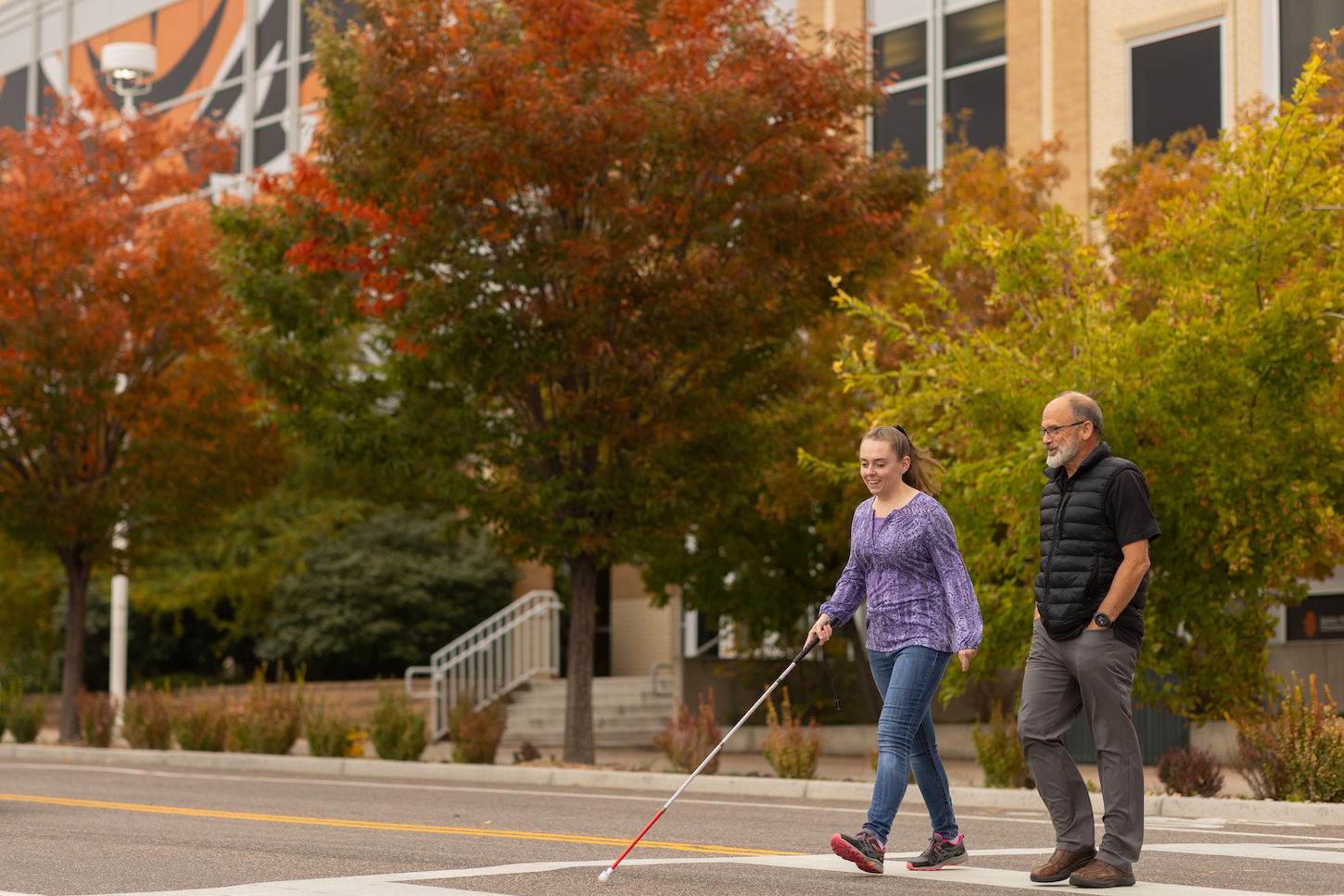Blind Awareness Month: Courtesy as a Rule
October 16, 2023

October is Blind Awareness Month and Idaho State University Disability Services is celebrating it by offering some tips on interacting appropriately with students, faculty, or Pocatello residents who are blind or visually impaired.
The Idaho Commission for the Blind and Visually Impaired has created some videos on Orientation and Mobility, including one on Human Guide Techniques, that offer suggestions about how to be an effective guide. The main points include:
- ask first
- try to communicate in a respectful manner, and
- 3) think of the perspective of the blind or visually impaired person.
“Blindness is not an indication of inability,” said April Mills, Certified Orientation & Mobility Specialist for the Pocatello office of Idaho Commission for the Blind and Visually Impaired. “Blind or low vision travelers have received specialized training to use a white cane or a guide dog to navigate in the community. In combination with alternative skills, most visually impaired travelers don’t need additional assistance.”
ISU students and employees who are blind have reported people unintentionally acting inappropriately when trying to assist them. One employee mentioned a stranger grabbed her white cane in an attempt to help her when she was exiting a bus. Grabbing a blind traveler’s body/cane or attempting to pet a guide dog is intrusive.
Quincie Mattick, a social work graduate student at ISU, has had so many people try to pet her service dog, Tessa, that she has put a sign on its harness asking people not to pet the dog while she is working. If a guide dog has its harness on it is working.
Interactions like this can result in everything from minor social discomfort to total disorientation—which can lead to more significant safety issues and routinely makes travel more challenging than absolutely necessary. Mills recommends if you are concerned about a visually impaired traveler, it is ok to ask if they need support; but not ok to outright grab someone.
“The best courtesy you can offer is to wait to be asked for help. Blind and low-vision travelers often know of your presence without having to be alerted,” Mills said.
“There are instances when I'm crossing the street alone or with other visually impaired friends, where strangers might grab us and try to help us across the street, which is not very cool,” noted Nicole Hill, a senior social work major at ISU who uses a white cane while walking.
When interacting with a person who is visually impaired, Mills recommends considering the encounter from the perspective of anyone who uses prescription glasses, also a form of vision impairment.
“If I approached someone with prescription glasses and just grabbed them, it would definitely be awkward for all involved.” Mills said. “Just as glasses are a tool for near- or far-sighted people, the white cane or a guide dog is a tool for blind or low-vision travelers.”
The National Federation of the Blind has created Courtesy Rules of Blindness that include eight tips about interacting with blind and low-vision people. Each line begins with an acrostic word association for the individual letters in the word “courtesy.” Two very good tips follow
- The letter “C” represents the cane and states: “My cane (or guide dog) is my independent travel aid. If you think I might need help, please just ask me”;
- The letter “Y” represents the need to “yield” and states: “In all 50 states, the law requires drivers to yield the right of way when they see my extended white cane or guide dog. Only the blind may legally carry white canes. I listen to traffic patterns to know when to cross streets and to keep a straight line when moving around.”
The rules are pretty simple and worth reviewing at the link above.
Although individual preferences vary widely, if asked to provide human guide support to a blind or visually impaired person who is in transit, please don’t touch them without permission. Often the blind or visually impaired person will offer their hand or raise an elbow and will provide instructions on how to assist them. For a person using a guide dog, positioning might be different than one using a white cane. Hill, for example, likes to grasp the guide’s elbow and follow a step behind so she can still use her cane.
“A lot of times the human guiding is supplemental, not necessary,” she said.
What is more helpful is clear, concise information.
“There have been times when I've been crossing streets here and people just say ‘hey, just so you know it's clear, you can cross,’” Hill said. “What would be really helpful is if people were to say, ‘hey, the light just changed and it's clear.’ More details are better.”
For more information on accessibility, visit Accessibility at ISU.
Categories:
